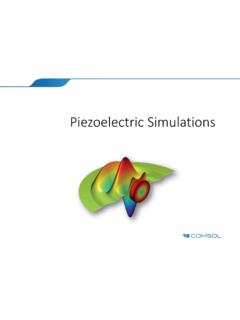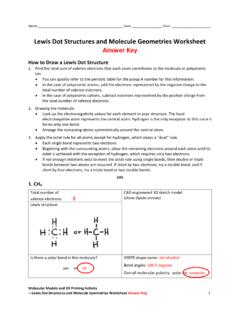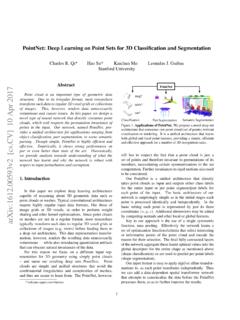Transcription of Predictive Models of Li-ion Battery Lifetime - NREL
1 nrel is a national laboratory of the Department of Energy, Office of Energy Efficiency and Renewable Energy, operated by the Alliance for Sustainable Energy, LLC. Predictive Models of Li-ion Battery Lifetime Kandler Smith, Eric Wood, Shriram Santhanagopalan, Gi-Heon Kim, Ying Shi, Ahmad Pesaran National Renewable Energy Laboratory Golden, Colorado IEEE Conference on Reliability Science for Advanced Materials and Devices Colorado School of Mines Golden, Colorado September 7-9, 2014 nrel /PR-5400-62813 2 Key Messages Semi-empirical Battery Lifetime Models are generally suitable for system design & control oLong-term validation still needed oStandardization would benefit industry oCharacterization requires expensive cell aging experiments Physics Lifetime Models are needed to reduce test time as well as guide future cell design oOpen questions remain how best to model electrochemo-thermo-mechanical processes across length- and time-scales Liu et al.
2 , J. Echem Soc. (2010) nrel Life & MSMD Models 3 Thermal nrel Electrochemical/Thermal/Life Models Multi-Scale Multi-Domain (MSMD) model Inter-domain coupling of field variables, source terms Efficient, flexible framework for physics expansion Leading approach for large-cell computer-aided engineering Models Kim et al. (2011) Multi-Domain modeling of Lithium-Ion Batteries Encompassing Multi-Physics in Varied Length Scales , J. of Electrochemistry, Vol. 158, No. 8, pp. A955 A969 Electrochemical Current Collector (Cu)Current Collector (Al)pNegativeElectrodeSeparatorPositiveE lectrode4 Life- Predictive model Physics-based surrogate Models tuned to aging test data Implemented in system design studies & real-time control Regression to NCA, FeP, NMC chemistries 15 C20 C25 C30 C10 CMinneapolisHoustonPhoenixLi-ion graphite/nickelatelif e.
3 PHEV20, 1 cycle/day 54% DoDNo coolingAir coolingAir cooling, low resistance cellPhoenix, AZ ambient conditions33 miles/day driving, 2 trips/dayLiquid cooling, chilled fluidIl l ustr ati on by Josh Bauer , N R ELNREL Electrochemical/Thermal/Life Models NCA = Nickel-Cobalt-Aluminum FeP = Iron Phosphate NMC = Nickel-Manganese-Cobalt 5 Outline Background Li-ion Batteries oWorking principles oElectrochemical window oDegradation mechanisms Life Predictive modeling Automotive Life Studies & Control 6 Li+ VWorking Principles VNeg. Electrode Graphite Hard carbon Silicon Titanate Li foil Pos. Electrode LiXO2, X = NiMnCo Co NiCoAl LiMn2O4, LiFeP04 7 Electrochemical Operating Window Potential vs. Li (V) SOC (x in LixC6 or y in Li1- ) 0% SOC 100% SOC Potential measured at cell terminals charge discharge Figure credit: Ilan Gur (ARPA-E) & Venkat Srinivasan (LBNL), 2007 8 Electrochemical Window Degradation Potential vs.
4 Li (V) SOC (x in LixC6 or y in Li1- )O2) Figure credit: Ilan Gur (ARPA-E) & Venkat Srinivasan (LBNL) 2007 9 Negative Electrode Degradation (Graphite) Graphene layer Graphite exfoliation, cracking (gas formation, solvent co-intercalation) Electrolyte decomposition and SEI formation SEI conversion, stabilization and growth SEI dissolution, precipitation Positive/negative interactions Lithium plating and subsequent corrosion Donor solvent SEI Li+ 1) Manufacturing environment 2) Application environment i) graceful fade (time at high T,SOC) ii) sudden fade/ damage (cycling at low T) Figure credit: Vetter et al., Journal Power Sources, 2005 Negative/ electrolyte interactions 10 Positive Electrode Degradation (Metal Oxide) Positive/negative interactions X.
5 Xiao et al., Echem Comm., 32 (2013) 31-34. Positive/electrolyte interactions Figure credit: Vetter et al., Journal Power Sources, 2005 11 Mechanical Coupled Stress & Degradation Least understood amongst ECTM physics Figure credit: Santhanagopalan, Smith, et al., Artech House (in press) 12 Mechanical Coupled Stress & Degradation Examples Cannarella, J. Power Sources (2014) Diercks, Packard, Smith et al., J. Echem Soc (2014) Figure credit: Santhanagopalan, Smith, et al., Artech House (in press) 13 Outline Background Li-ion Batteries Life Predictive modeling oPhysics-based oSemi-empirical Automotive Life Studies & Control 14 Degradation Mechanism vs. Length Scale 10-10 10-8 10-6 10-4 10-2 10-0
6 Chemistry SEI growth Li plating Electrolyte decomposition Gas generation Particle scale SEI -cracking Fracture, damage of transport paths Phase evolution, voltage droop Electrode scale Electrode creep, delamination, isolation Separator pore closure Pore clogging Cell scale 3D elec, thermal, mech.
7 Inhomogeneities Tab effects Stack/wind Module scale Thermal & mechanical boundary conditions 15 Macro-scale Stress Model 10-10 10-8 10-6 10-4 10-2 10-0 Stress/strain due to thermal and electrode bulk concentration changes Coupled echem & thermal Behrou, Maute, Smith, ECS Mtg.
8 (2014) 16 Micro-scale Stress/Degradation Model 10-10 10-8 10-6 10-4 10-2 10-0
9 Damage evolution Performance impact An, Barai, Smith, Mukherjee, JES 2014 17 nrel Life Predictive Model Data: Hall, IECEC, 2006. 17 Relative Capacity (%) Time (years) r2 = Li-ion NCA chemistry Arrhenius-Tafel-Wohler model describing a2( DOD,T, V) NCA Correct separation of calendar vs.
10 Cycling degradation for extrapolation of year testing to 10+ year life Extensible to untested drive cycles, environments (state form) Relative Resistance Relative Capacity Qsites = c0 + c2 N + .. R = a1 t z + a2 N Calendar fade SEI growth Loss of cyclable lithium Coupled with cycling a1, b1 = f( DOD,T,Voc,..) Q = min ( QLi , Qsites ) QLi = b0 + b1 t z + .. Cycling fade Active material structure degradation and mechanical fracture a2, c2 = f( DOD,T,Voc ,..) NCA 18 Knee in Fade Critical for Predicting End of Life Example simulation: 1 cycle/day at 25 C 50% DOD: Graceful fade controlled by Li loss ~ t1/2 80% DOD: Transitions to electrode site loss, N ~ 2300 cycles Life over-predicted by 25% without accounting for transition from Li loss (~chemical) to site loss (~mechanical) NCA Time (Days) 19 Electrode Site Loss Cell Aging Data Graphite/iron-phosphate meta-dataset from multiple labs FeP 20 Electrode Site Loss Cell Aging Data Graphite/iron-phosphate meta-dataset from multiple labs 13 of 50+ test conditions show apparent knee in capacity fade curve FeP 21 Electrode Site Loss Model (graphite/iron phosphate) ()()[]()()().

















